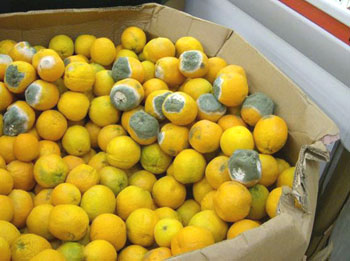Has anyone had any experience with storing oranges along with products that produce ethylene gas? A reader has noticed that once they changed their storage of oranges, with other ethylene producing commodites, the oranges have showed an increase in decay. Is there a corrolation between the two? Your comments would be appreciated.


6 Comments on “Oranges- Ethylene Gas”
I can understand that ethylene may hurry-up the ripening process on all fruits, but I assume it would depend on the concentration, and the location of the ethylene-producing fruits, in relation to the oranges, if they would promote the advancement of decay.
If the oranges were in a small refrig cooler along with some high ethylene producers……..maybe, but if they were in a large warehouse cooler I can’t see it being a factor.
Etyhlene is a ripening gas, so in effect it would make the product “more orange” quicker. From experience, ethylene will be put onto products. Rarely, it would be flushed into the packaging.
It all depends on your type of storage. If you are packing it in the same package as that which has been flushed, yes it would mature quicker than in atmosphere. If there is a leak (e.g. incorrect micron on the ethylene packed products)and the oranges are in the same enclosure, yet again it would mature at a quicker rate.
I think that the most important factors to consider is the grade of oranges before packaging (if they are almost ripe on transit, they are more susceptible to maturing); the type of packaging and the way they are stacked for transit.
On the flip side, flushing the oranges with Nitrogen will delay the ripening process.
I just could not go away your web site prior to suggesting that I really enjoyed the standard information a person supply
for your visitors? Is gonna be back frequently to investigate cross-check new posts
It’s not my first time to visit this web page, i am
visiting this website dailly and get good facts from here every day.
Ethylene increases maturation rate of fruits and vegetables. In citrus industry, it is used for degreening, using for example 1-10 ppm concentration during 2 to 5 days at 20°C. If used in too high concentration, long exposure or high temperature, it may cause penicillium development (what we see on the photo above), specially if citrus has not received previous fungicide treatment. So, in my opinion there is a correlation between the citrus decay and storage with products that produce ethylene.
You can use ethylene absorber and orange must be drenched good with 500 ppm imazalil and 1000 ppm orthophenyl phenol and may be also with 800 ppm pyrimethamil or 600 ppm fludioxonil or together and waxed also with coating wax like poly oxidizes poly ethylene wax or carnuba wax or others coating wax with also fungicides like imazalil (2000 ppm) and thiabedazole 3000 ppm and put in recommended temperature 4 to 8 celuis. It’s shelf life may be reached more than 3 months .